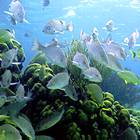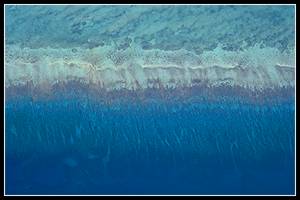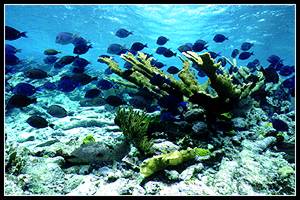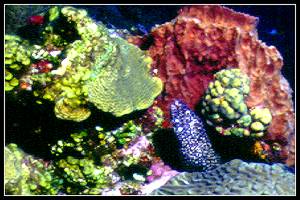|
| |

|
ZONE A
Hol Chan's one square mile coral reef zone can be divided into four habitats:the back reef, reef crest, fore reef, and the channel or cut across the barrier reef.
|

|
||||
Approximately .75 (linear) miles of the back reef habitat is north of the channel. This section is separated from the grassbeds by a "sand row" approximately 40 meters wide which has no seagrass cover. This sandy area is inhabited by a wide variety of mollusca including the Queen conch (Strombus gigas).
However, a variety of other encrusting corals and sponges have attached to the dead sections. The large surface area of sheltered overhangs or caves formed by these elkhorn assemblages form the main habitat for Hol Chan's impressive lobster population. During one survey, over seventy lobsters were found under one such elkhorn projection. Other corals such as brain corals (Diploria spp.), Starlet corals (Siderastrea spp.), boulder corals (Montastrea spp.), some patches of Staghorn coral (Acropora cervicornis), along with numerous sea fans (Gorgonia spp.) and other soft corals are dispersed throughout the area. Large schools of blue tangs and grunts are common, as are triggerfish, hog fish, parrot fish, barracuda and nurse sharks. Black tipped reef sharks and juvenile sea turtles (probably logger head, Caretta caretta)are occasionally seen. The reef crest foundation consists primarily of dead elkhorn and boulder corals, amalgamated into "reef cement" and covered with turf algas and fire coral (Millepora spp.). the depth of this high energy wave zone is generally .4 meters to 0 meters, with numerous dead elkhorn coral tips breaking the water's surface during low tides. There are several deeper areas or "mini-cuts" which allow further water exchange and passage across the reef for some smaller schools of fish.
The Hol Chan Channel is the most often visited area in the reserve. This channel differs from other channels off Ambergris due to its greater depth (10 meters) and nearly vertical sides partially covered with live corals and interspersed with caverns.
While the upper 2 meters of the channel walls are covered with live corals (Porites, Agaricia, Diploria, Montastrea) the lower ledges are primarily dead coral covered with algae. Inside several eroded caves in these lower walls are large resident green moray eels. The Hol Chan fore reef is representative of the Northern Belize Shelf habitat. Sparse low-relief coral coverage (including soft corals) extends from the outer reef crest from approximately 5 to 13 meters, where the characteristic spur and groove formations begin. These coral assemblages form hills of coral with valleys of sand running perpendicular to the reef crest. At approximately 20 meters these formations become well developed, with average heights of approximately 7 - 8 meters. One unusually large assemblage of pillar corals (Dendrogyra cylindrus) is located about mid-way along the linear mile of fore reef at a depth of about 15 meters. This popular dive site is frequented by quite tame nassau groupers and yellow tail snappers. The fore reef has the highest diversity of coral species including large tracts of Lettuce corals (Agaricia spp.) which dominate the tops of the spurs. Numerous sponges are interspersed along the spur sides. In addition to the characteristic species of reef fish, sightings of Spotted dolphins, Green and Loggerhead sea turtles have also been reported in the Hol Chan fore reef. | ||||||
| Zone A - Coral Reef | Zone B - Grass Beds | Zone C - Mangrove | Zone D - Shark-Ray Alley |
|
Copyright ©
- Naturalight Productions Ltd.
The URL of this page is: |
 The depth of this "sand row" is approximately 1.75 meters, while the remainder of the back reef habitat (both north and south of the cut) has a depth of about one meter. This northern back reef habitat is characterized by large formations of elkhorn coral (Acropora palmata) which grow out in finger-like projections perpendicular to the reef crest. There is a high degree of bioerosion of these corals, particularly those closer to the reef crest.
The depth of this "sand row" is approximately 1.75 meters, while the remainder of the back reef habitat (both north and south of the cut) has a depth of about one meter. This northern back reef habitat is characterized by large formations of elkhorn coral (Acropora palmata) which grow out in finger-like projections perpendicular to the reef crest. There is a high degree of bioerosion of these corals, particularly those closer to the reef crest.
 The .25 (linear) miles of back reef south of the cut is characterized by large formations of finger corals (Porites spp.) and lettuce corals (Agaricia spp.) which cover large areas perpendicular to the reef crest. Near the southern border is a shallow region of coral rubble and sand covered with Dictoyta spp. algae.
The .25 (linear) miles of back reef south of the cut is characterized by large formations of finger corals (Porites spp.) and lettuce corals (Agaricia spp.) which cover large areas perpendicular to the reef crest. Near the southern border is a shallow region of coral rubble and sand covered with Dictoyta spp. algae.
 The leeward channel opening contains a patch reef complex dominated by Boulder coral (M. annularis), Brain corals (Diploria spp.) and Starlet corals (Sidrastrea spp.). The depth of this area is generally 1 - 2 meters, sloping downward to the 10 meter depth of the sandy channel as one moves seaward. This leeward area contains the boat moorings and is always inhabited by schools of snappers(yellow-tail, dog, grey, and schoolmaster),numerous grunts, and normally several large black or nassau groupers. The channel itself is often visited by schools of Atlantic spadefish and Permit. Sightings of Tarpon, Hammerhead sharks and West Indian Manatee in the channel are reported occasionally.
The leeward channel opening contains a patch reef complex dominated by Boulder coral (M. annularis), Brain corals (Diploria spp.) and Starlet corals (Sidrastrea spp.). The depth of this area is generally 1 - 2 meters, sloping downward to the 10 meter depth of the sandy channel as one moves seaward. This leeward area contains the boat moorings and is always inhabited by schools of snappers(yellow-tail, dog, grey, and schoolmaster),numerous grunts, and normally several large black or nassau groupers. The channel itself is often visited by schools of Atlantic spadefish and Permit. Sightings of Tarpon, Hammerhead sharks and West Indian Manatee in the channel are reported occasionally.
 On the seaward end of the channel the depth decreases to approximately 6 meters and the channel walls level off, resulting in a low relief dispersal of hard and soft corals, gently sloping into the fore reef.
On the seaward end of the channel the depth decreases to approximately 6 meters and the channel walls level off, resulting in a low relief dispersal of hard and soft corals, gently sloping into the fore reef.